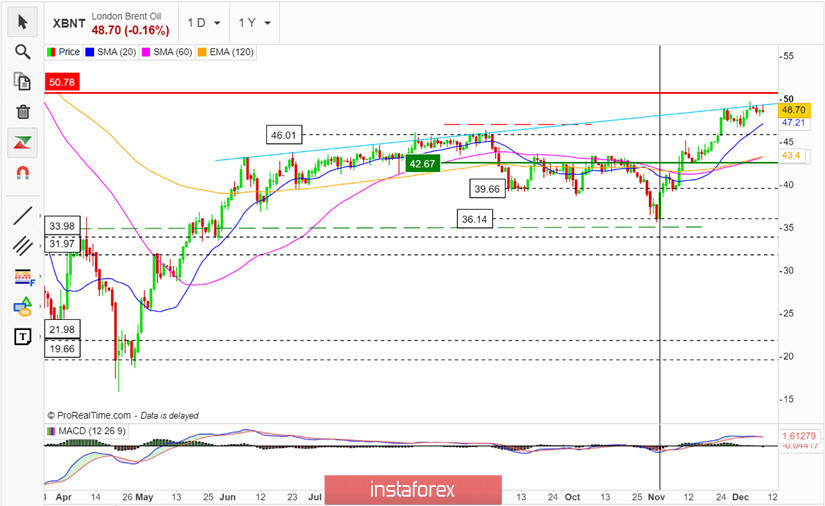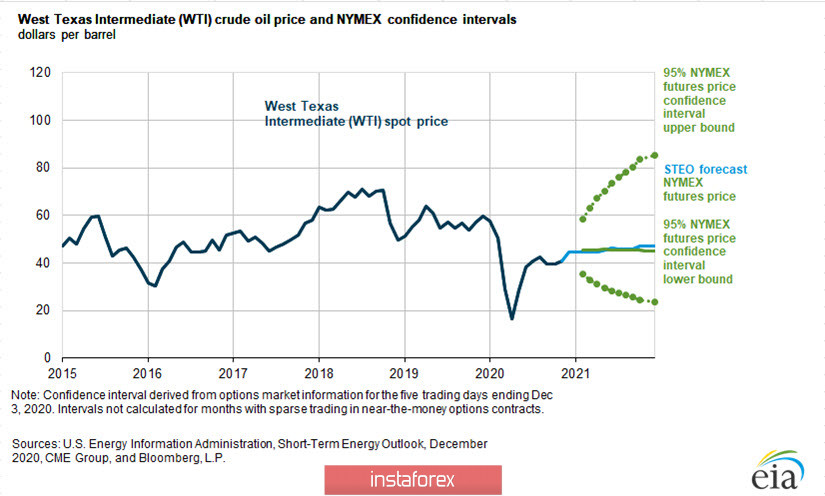
This year has been a difficult test for most of the inhabitants of the planet Earth. Under the influence of the COVID-19 pandemic, oil prices fell to negative values, but by the summer everything more or less normalized. After a period of autumn decline, the price of oil began to grow actively again, and reached $50 for the North Sea Brent grade and $45 for the North American WTI grade in December. Positive stock markets, hopes for an early vaccination and the appointment of Joe Biden as president served as a driver for maintaining an optimistic mood in the oil market. The extension of the OPEC + deal, which implies an increase in production by 500 thousand barrels per month, despite obvious contradictions among the participants, was also met positively. However, as you know, there is only one step from love to hate, and in the context of the current situation, we should think carefully: can oil prices continue to increase in the current conditions, or should we expect at least a correction?
The main factors affecting oil are the growth of the global economy, the level of production, the weakness of the US dollar and the sentiment of the futures market participants. Despite the fact that China has become the main importer of oil, which is increasingly pushing the United States from the position of the world leader, oil pricing is still carried out in dollars, and Chinese exchanges still lag behind American futures markets in terms of trading volumes.
The US dollar has been actively declining in the past few weeks, which was a reflection of the general jubilation on world stock markets, this positive and supported oil in its upward trend. Moreover, the period of recovery in oil prices almost completely coincided with the period of decline in the dollar, which began at the end of October (Fig.1).

Figure 1: The growth of oil prices began on November 2, simultaneously with the beginning of the decline in the US dollar
It would seem that the dollar does not shine for strengthening but let me remind you that on Thursday, December 10, there will be a meeting of the European Central Bank, which can significantly affect the euro exchange rate, and next Wednesday the monetary policy decision will make the U.S. Federal Reserve. The euro is essentially an antagonist of the dollar, and takes about 60% of the total exchange rate of the US currency. Thus, a decrease in the EUR/USD exchange rate, if it occurs, will automatically increase the dollar exchange rate, which means that it will put pressure on the oil price. The relationship between oil and the EUR/USD exchange rate is not correlative, but there should be no doubt that the euro and the oil price are moving in the same direction. Even if this does not happen immediately, the average delay is no more than two weeks.
Despite the increase in prices, demand in the oil futures market remains weak, at the level of 2017, and is about 2.5 million contracts, while before the pandemic, demand was above 3.5 million contracts. At the end of November 2020, feeling the recovery of the market, speculators revived and began to buy oil, but so far very hesitantly, as if fearing a second wave of recession covering the world economy. Their fears were fully justified on Wednesday, December 9, when a report from the US Department of Energy showed an increase in inventories, which amounted to 15.2 million barrels, while the forecast suggested a decrease of 1.4 million barrels.
On December 8, the US Department of Energy (US EIA) published a monthly short-term forecast, according to which the average price of Brent crude oil in 2021 will be $ 49 per barrel. The forecast for rising crude oil prices next year reflects the EIA's expectations that inventories will remain high. However, as global demand increases and OPEC + oil production curbs, inventories will shrink. The EIA predicts that the price of Brent oil in the first quarter of 2021 will average $ 47 per barrel, and by the fourth quarter will rise to $ 50.
The average price in the first quarter of 2021 will be $ 5 more than predicted in the short-term forecast for last month, in the fourth quarter of this year, the price will be higher by $1.
According to the Ministry of Energy, the higher expected prices for the first quarter reflect a sharper reduction in global oil reserves as a result of the OPEC + decision of December 3. The EIA expects that high levels of global oil reserves and excess production capacity will limit the growth of the oil price for most of 2021. At the same time, traders of the NYMEX exchange have approximately the same vision of the price, but assume that in January the price of WTI oil is 95 percent likely to be above $35.31 and below $58.48, considering the average trend of January prices at $45.44 (Fig. 2).

Figure 2: Forecast of WTI oil price dynamics for 2020-2021
As you can see, the forecast from the Ministry of Energy is quite optimistic, but it seems to me that it does not take into account the factors of closing the European economy, possible decline in stock markets, contesting the results of the US election, as well as the failure of the initial vaccination deadlines. All these events, taken together and separately, can significantly affect the short-term dynamics of oil prices.
A deep decline in oil prices, which was in March, is hardly possible now in my opinion, but a short-term correction is quite real. Thus, the occurrence of a corrective decline in the oil market within the next few weeks is quite likely.
Be careful, and follow the rules of money management!





















